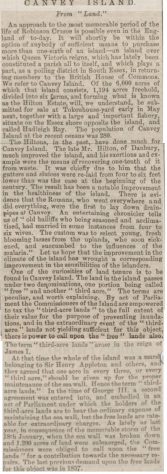Canvey Island
Chelmsford Chronicle - Friday 24 March 1882
From “Land.”

Newspaper clipping
An approach to the most memorable period of the life of Robinson Crusoe is possible even in the England of to-day. It will shortly be within the option of anybody of sufficient means to purchase more than one-sixth of an island—an island over which Queen Victoria reigns, which has lately been constituted a parish all to itself, and which plays a part, as a polling district in South Essex, in returning members to the British House of Commons. We refer to Canvey Island. Of the 6,000 acres of which that island consists, 1,194 acres freehold, divided into six farms, and forming what is known as the Hilton Estate, will, we understand, be submitted for sale at Tokenhouse-yard early in May next, together with a large and important fishery, situate on the Essex shore opposite the island, and called Hadleigh Ray. The population of Canvey Island at the recent census was 280.
The Hiltons in the past have done much for Canvey Island.
The late Mr. Hilton, of Danbury, much improved the island, and his exertions and example were the means of recovering one-tenth of it from waste. It was chiefly due to him that the gutters and sluices were re-laid from four to six feet lower than was the case at the beginning of the century. The result has been a notable improvement in the healthiness of the island. There is evidence that the Romans, who went everywhere and did everything, were the first to lay down drainpipes at Canvey. An entertaining chronicler tells us of “old bailiffs who being seasoned and acclimatised, had married in some instances from four to six wives. The custom was to select young, fresh blooming lasses from the uplands, who soon sickened, and succumbed to the influences of the malaria.” Let us hope that the improvement in the climate of the island has wrought a corresponding improvement in the sensibilities of the islanders.
One of the curiosities of land tenure is to be found in Canvey Island. The land in the island passes under two denominations, one portion being called “free” and another “third acre.” The terms are peculiar, and worth explaining. By act of Parliament the Commissioners of the Island are empowered to tax the “third-acre lands” to the full extent of their value for the purpose of preventing inundations, and in the extraordinary event of the “third-acre” lands not yielding sufficient for this object, there is power to call upon the “free” lands also.
The term “third-acre lands “arose in the reign of James I. At that time the whole of the island was a marsh belonging to Sir Henry Appleton and others, and they agreed that one acre in every three, or every
“third acre,” should be given up for the proper maintenance of the sea wall. Hence the term “third-acre lands.” In the time of George III, a second agreement was entered into, and embodied in an act of Parliament under which the holders of the third-acre lands are to bear the ordinary expense of maintaining the sea wall, but the free lands are rateable for extraordinary charges. As lately as last year, in consequence of the memorable storm of the 18th January, when the sea wall was broken down and 1,200 acres of land were submerged, the Commissioners were obliged to call upon the “free lands” for a contribution towards the necessary repairs. The last previous demand upon the free lands for this object was in 1837.




No Comments
Add a comment about this page